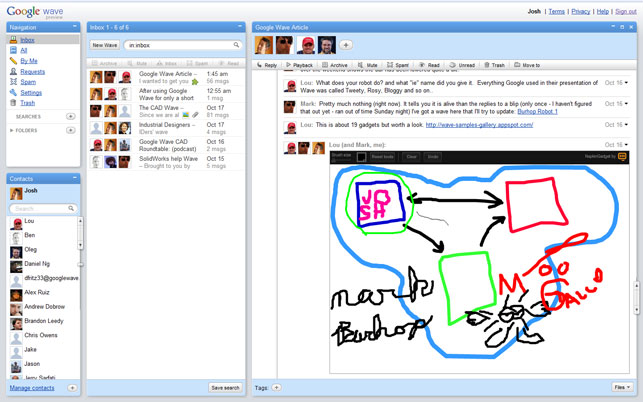Google Wave is the latest development from ol’ mother Google, which takes a fresh look at collaboration. Could this mean an end to email? wonders Josh Mings along with all the other Wave participants who wrote this article
At this very moment I’m creating this article in Google Wave. At the same time there are four other people that can see every word I type and every edit I make. They are also able to edit the document themselves and add their own content. This is real-time collaboration in the truest sense. With a big term like that, there’s bound to be some productivity spewing out of somewhere.. or someone. To figure out exactly what that means, I’m going to pick apart the latest product from ol’ mother Google, to see exactly what benefits Google Wave brings and what this could mean for anyone remotely interested, or involved, in product development.

Google Wave is like your email Inbox, where each email is simply one conversation, called a wave, instead of the ridiculous reply, upon reply, upon reply
What is Google Wave?
To get the basic idea out of the way, imagine this. You’re at conference table full of people discussing the strike speed of trap-jaw ant mandibles, except you don’t have to listen to all those people yap at once and you can boot anyone out if they’re being really annoying. You can also see what they are saying, add to it, change it or just delete it like they’re not there at all. Now, doesn’t that sound more productive already? Google Wave is also like your email Inbox, where each email is simply one conversation, called a wave. One conversation, instead of the ridiculous reply, upon reply, upon copy, upon ‘why-did-I-even-take-the-bullets-out-of-that-gun’ response you want to send. It ends that. One email, one conversation, one wave. That is Google Wave.
So, as you imagine a wave being a real-time hub of interactive conversation, you may also imagine it being quite busy. Waves are as public or as private as you want them to be, but when they are public, whoever is there, sees whatever is there. Sometimes you may just not want that. I’ll say right now, writing this article in a Wave is a tad disconcerting knowing that everyone else can see me lathering up in the steamy collaborative environment. Soap please… Putting that uncomfortable thought aside, it’s simple. You start a wave as you would any email, then you add the people you want.
With real-time collaboration there are also real-time mistakes and real-time distractions. Perhaps it’s all part of the process, or perhaps we’ll all soon be saying… remember email?
They in turn, can add people they want. So, now all of you are part of one, big happy sing-along conversation happening in a single spot on the web, all in real-time.
What value does the real-time component add? Plenty. While people may shudder to think that two people typing on a page at the same time could add any value, it’s actually quite different than if two, three or even sixty people were talking in a room together simultaneously – firstly, because it’s more than just holding hands and typing together.
Along with being able to insert images or add attachments as you would with regular email, Google Wave allows you to add extensions. Extensions can be embedded games, video, conference tools or custom programs. Secondly, you can embed Waves into web pages, web apps and, yes, even offline programs. Those easily bring the real-time effect into static environments we’ve often viewed as collaborative.
What problem does it solve?
You can shove real-time this and that into every crevice of your online existence, but even without that there are a few things Google Wave does that make it a valuable tool. Currently, we have a very annoying problem that goes along with the joys of email. There’s too damn much of it.
For most of us, our day starts with it, ends with it and fills all the gaps in between. With Google Wave it’s different. There is no delay, like with email and there is no need to be there, like with Instant Messaging (that very point came from Mark Burhop, a Product Manager at Siemens PLM Software, who is collaborating with me on this article). That’s important, because with each email filling our inbox, we’re obligated to open, answer, forward or delete it and act like we never got it. Within a Wave, that sense is stripped. Conversations happen faster when you’re live with someone, but they can also wait, or get input from others if you’re not there.
On top of that, Google Wave disrupts the essay length email message that makes all time rot away into oblivion. Instead, a Wave allows discussion to happen in shorter, more digestable spurts, just like regular dialogue. In addition, shorter comments tend to happen because it’s much like you’re simply starting a chat rather than creating a document. All of it combines to either make people more efficient or reduce them to jibberish talk and short insults in a game of Soduku. Time will tell, but whatever a Wave contains, it’s set up to make the going back and forth between people much, much faster.
How can it be used in Product Development?
It’s almost obvious, except it’s not. Collaboration and product development go together, but the collaborative design process is typically us… at our desks, connected by poorly organised meetings. Not necessarily the hive-mind definition of co-existing disciplines is it? From a simple day-to-day email style workflow, Google Wave keeps conversations about a design or project consolidated, allowing all that real-time goodness to ooze out of everyone’s creative little fingertips.
Now, talking live about a design or project is OK, but what we all want to see when we envisage real-time collaboration is two people, on separate continents, working on a design together. In Google Wave, it’s not there… yet. Maybe it will never be. However, as Google is a company already involved in delivering interactive 3D content over the web through products like SketchUp, 3DWarehouse, the O3D open-source Web API, plus crowdsourcing the creation of entire cities in 3D for Google Earth, you have to wonder what’s next.
What you may be surprised to learn is that some companies in the product development industry have already been stewing in their own web-based collaboration juices. Which, by every indicator, puts the MCAD/PLM market a little ahead in thinking about co-ordinating real-time activities. In the PLM scene, real-time product visibility and interaction is already happening within Dassault’s ENOVIA V6 platform. The web accessible service-oriented architecture (SOA) allows real-time collaboration from engineering design to manufacturing.
You’ll also get a taste of it, minus the real-time attribute, inside Vuuch, a web-based program that allows you to create consolidated discussions around parts within the product development environment. So, for some in product design it’s already happening. Google Wave may or may not threaten what’s already happening there. However, early adopters and developers using Google Wave are already exploring what the possibilities are.
Conclusion
When it comes down to working in Google Wave, honestly, it is just plain scary. People are seeing what I’m writing as a write it. It’s uncomfortable. We are just not used to collaborating in this way with people. However, it’s also extremely cool. The potential for huge amounts of collaboration are there. Real-time web apps are being discussed and set up as the standard way to deliver information online for the future. Even though that’s happening, the effect Google Wave has is even bigger. It’s already changing the way I think about communicating with people. For example, I’m finding that when I need to contact someone, I think, oh good, they’re on Wave and I can talk to them through that rather than sending an email or IM.
It’s transitioning how I want to get in touch with people, in much the same way that email replaced actually having to confront someone about their body odour. The wall this backs onto is that many people and companies are deeply embedded with how email works. Companies that don’t use web apps are less likely to use Wave, people that don’t like others seeing what they’re doing won’t like it either. Where real-time collaboration is happening, there are also real-time mistakes and real-time distractions. Perhaps it’s all part of the process, or perhaps we’ll all soon be saying… remember email?
{encode=”josh@solidsmack.com” title=”Josh Mings”} is a mechanical engineer in the aircraft interiors industry and the brains behind solidsmack.com. He wonders if he could use Google Wave to get his peers to write all of his future articles without them realising.

Josh Mings re-learns the art of communication






